#Saint Moses the Black
Explore tagged Tumblr posts
Text

Saint Moses the Black (The Ethiopian)
Desert Father
330-405
Feast Day: August 28
Patronage: Africa, forgiveness, nonviolence
Saint Moses the Black was an Ethiopian with great physical strength, who traveled to Egypt for adventure but got a lowly servant job. Dissatisfied with this, he turned to robbery and terrorizing the villages on the Nile. Before authorities could arrest him, he fled to a Coptic Orthodox Monastery and eventually had a conversion and became a monk. When thieves attacked the monastery, he captured them, showing pity. The thieves then too became monks. After years of humbly preaching forgiveness, he was killed trying to protect the monastery, but not before he saved 70 brother monks.
Prints, plaques & holy cards available for purchase here: (website)
#Saint Moses the Black#Black saint#Saint for forgivness#catholic art#catholic faith#artist on tumblr
77 notes
·
View notes
Text
Saint Moses the Black, also known as Moses the Ethiopian
Saint Moses the Black, also known as Moses the Strong, Moses the Abyssinian, Moses the Robber, and Moses the Ethiopian, was a remarkable ascetic monk and priest who lived in Egypt during the fourth century AD. He is widely revered in both the Eastern Orthodox Church and the Oriental Orthodox Church for his inspiring journey of transformation and spiritual devotion. Moses’s life is an…

View On WordPress
#African Figure#African Historical Figure#African History#North African Historical Figure#Religion History#Saint Moses the Black
0 notes
Text
really taken with how Louis is the only one of his siblings without a religiously coded name. Paul as in the apostle, constantly talking about what the Lord wants and trying to guide Louis in the right direction through his preaching. Grace as in the freely given, pure love and forgiveness offered by God, the sweet sound that can save any sinner. Louis loses Paul and then he loves the Devil, forever turning his back on Grace.
#he’s surrounded by religious names actually#Jonah Macon - as in Jonah and the Whale#Levi Freiner (Grace’s man) - same first name as Moses’ great grandfather (and I’m pretty sure the name has connotations of reconciliation)#the only non-religiously named family member is his mother Florence#and she’s everything but a saint to him#I don’t think it was intentional btw they’re Black NOLA people from the 19th to early 20th c. they’re going to have biblical names#but still… interesting how it happened#(intentional from a writing perspective but who knows I might be wrong)#louis de pointe du lac#ldpdl#grace de pointe du lac#paul de pointe du lac#iwtv#interview with the vampire
57 notes
·
View notes
Text


About St Moses the Black
About St Hildegard of Bingen
Losers' Bracket Round 1
#st moses the black#st hildegard of bingen#christianity#polls#tumblr bracket#catholic#catholicism#catholic saint tournament#catholic saints#tumblr tournament#theology#tumblr polls
12 notes
·
View notes
Text
IWTV Season Three Influences & References (so far) 😉
Season 2 here, Season 1 here
The First 21: How I Became Nikki Sixx by Nikki Sixx
Black Metal Rainbows edited by Daniel Lukes & Stanimir Panayotov
The Heroin Diaries by Nikki Sixx
The Art of Darkness: The History of Goth by John Robb
Set the Night on Fire by Robbie Kreiger
The Dirt: True Confessions of the World’s Most Notorious Rock Band by Tommy Lee, Mick Mars, Vince Neil and Nikki Sixx
The Rocky Horror Picture Show (1975)
Hedwig and the Angry Inch (2001)
Musical Influences (Most Mentioned at the SDCC24 panel by Rolin Jones and Daniel Hart) :
David Bowie (particularly mid 70s/ Ziggy Stardust)
Mick Jagger of The Rolling Stones
Robert Plant of Led Zeppelin
Jim Morrison of the Doors
John Cale of the Velvet Underground
Freddie Mercury of Queen
Nick Cave of the Bad Seeds
David Lee Roth of Van Halen
Nicki Sixx of Motley Crue
Acl Rose of Guns N’ Roses (credit to @jwdancerina on twt)
Nirvana cited by Daniel Hart during Reddit AMA
Sting and The Police (? Unconfirmed)
Iggy Pop
Prince
Otis Redding
Mark Sandman
Ryan Kattner
Chappell Roan
Brandon Flowers of The Killers
Bjork
Fiona Apple
Daniel Hart
T-Rex
Beastie Boys
The White Stripes
Redd Kross
Tim Rose
Serge Gainsbourg
Electric Light Orchestra
Sweet
Florence Welsh
Saint Vincent
Raleigh Ritchie
Benjamin Clementine
Moses Sumney
Douglas Dare
Jeff Magnum
Paul Westerberg of the Replacements
Franz Liszt
Shostakovich
Gustave Mahler
Lang Lang
Martha Argerich
Gustavo Dudamel
Maurice Ravel cited by Daniel Hart on X
118 notes
·
View notes
Note
Hi wolfy! So I’ve been scrolling through your religious tag I guess and i wanted to ask: do you know about saints? Like ones that aren’t in the Bible? As an orthodox we learn about them at church (specifically Egyptian ones cause it’s my country) like Moses the black or Habib girgis or mother irini. There are many more of course but this from the top of my head. Because I think Egyptian saints have very interesting stories, I personally enjoy them even more than the Bible ones.
Ooo! The saints interest me but there's so much that I haven't gotten into them yet agsjsvs. Even in the school I currently go to, which is a Catholic school, already has a bunch of saints like the lasallian brothers
157 notes
·
View notes
Text
Harriet's sign is a hook and the staff of Moses, laid out similar to the hammer and sickle. A red circle around the symbol means a stash spot or supply storage area, a black triangle means a medical depot, an inverted green triangle means a place where there is sickness, and a blue V symbolizes a safehouse. If the symbol doesn't have one of those signs, then the symbol is just a warning that this is Harriet's turf.
Diego's symbol is a red trident and a black guitar crossed like a crossbones. His is less symbolic and more to convey "This is definitely Diego’s."
Facilier's symbol is a black cat, I'm sure you can guess why
For Mischief Mile, the Facilier sisters use the silhouette of a black rooster over the cross of Saint Brigid. The rooster is a symbol of Maman Brigitte, and Saint Brigid's cross is because when Haitian Voodoo was being persecuted, worship of Maman Brigitte would often be disguised as worship of Saint Brigid.
Mordred's symbol is two ravens. They're Odin's ravens from Norse mythology. There's a rumour that Mordred's tags are magic, that, like the real Thought and Memory, the paintings watch and report what they see to Mordred, and fae acts accordingly
Maverick's symbol is the triple goddess (the two crescents and the full moon,) meaning the Morrigan, but few people know that because she doesn't usually do tags unless she really needs to publicly make a point that something is under her protection, like where Mara and Molly live.
Rose's symbol is a single red rose and stem that she puts a lot of detail into. Ace's symbol is a broken heart with a sword sticking out of it a bit like Excalibur. They use a crown with an anarchy A to mark their territory, and then their individual symbols are designated safepoints where people who need their help can find shelter. Once someone is in that shelter, they are under Rose and Ace's protection. The symbol isn't just a symbol of sanctuary, it's a warning to anyone who might have bad intentions. People stay away from places Rose and Ace mark.
Maddy's symbol is a white starling and a waning crescent. She's never told anyone the origins, but they represent the goddess Branwen, a woman who had no choice in her fate and whose suffering was what started a war between Britain and Ireland because she dared to try to gain her freedom from an abusive marriage. Her fate could not be changed and she was powerless to stop the pain, suffering, and bloodshed that would happen in her name. Who lost everything she loved and died drowning in her own grief. That's what Maddy chose.
#harriet hook#diego de vil#maverick mim#freddie facilier#celia facilier#mordred mim#rose hearts#ace hearts#ace of hearts#maddy mim#mad maddy#isle of darkness#descendants au#original character#descendants oc
12 notes
·
View notes
Text

Mary Fields (circa 1832–1914), also known as Stagecoach Mary and Black Mary, was the first African American female star route mail carrier in the United States.
Fields had the star route contract for the delivery of U.S. mail from Cascade, Montana, to Saint Peter's Mission.
She drove the route for two four-year contracts, from 1895 to 1899 and from 1899 to 1903.
Standing six feet tall and true to her fearless demeanor, she carried multiple firearms, most notably a .38 Smith & Wesson under her apron to protect herself and the mail from wolves, thieves and bandits, driving the route with horses and a mule named Moses.
Mary gained her nickname "Stagecoach Mary" due to her use of a stagecoach as a method of transportation to deliver the mail. She never missed a day. If the snow was too deep for her horses, Fields delivered the mail on snowshoes, carrying the sacks on her shoulders.
10 notes
·
View notes
Photo

Saint of the Day – 7 February – St Moses the Hermit (Died c389) Bishop and Apostle of the Saracens, Hermit in the desert and then Bishop, Missionary, Peace-maker. Moses had no fixed See after his Consecration as Bishop, journeying instead with his nomadic flock, converting many and keeping peace between the different tribes and the Roman imperial authorities. Born in Arabia and died there in c389 of natural causes. Also known as – Moses of the Saracens, Venerable Moses the Bishop. (Not to be confused with Moses the Black (330-405), another Saint of the region who is celebrated on 28 August.) The Roman Martyrology reads today: “In Egypt, St Moses, a venerable Bishop, who first led a solitary life in the desert and being afterwards made Bishop, at the request of Mauvia, the Queen of the Saracens, converted the great part of that barbarous oeiokes to the Faith and rich in merits, passed peacefully to his reward.”
(via Saint of the Day – 7 February – St Moses the Hermit (Died c389) Bishop and Apostle of the Saracens – AnaStpaul)
5 notes
·
View notes
Text
SAINTS&READING: TUESDAY, SEPTEMBER 10, 2024
august 28_september 10
VENERABLE MOSES THE BLACK OF SCETE (400)

Saint Moses lived in Egypt during the fourth century. He was an Ethiopian, and since he was black of skin he was called “Murin” (meaning “like an Ethiopian”). In his youth he was the slave of an important man, but after he committed a murder, his master banished him, and he joined a band of robbers.
Because of his bad character and great physical strength, they chose him as their leader. Moses and his band of brigands were feared because of their many evil exploits, including murders and robberies. People trembled at the mere mention of his name.
Moses the brigand spent several years leading a sinful life, but through the great mercy of God he repented, left his band of robbers and went to one of the desert monasteries. Here he wept for a long time, begging to be admitted as one of the brethren. The monks were not convinced of the sincerity of his repentance, but the former robber would neither be driven away nor silenced. He continued to implore that they accept him.
Saint Moses was completely obedient to the hegoumen and the brethren, and he poured forth many tears of sorrow for his sinful life. After a certain while Saint Moses withdrew to a solitary cell, where he spent his time in prayer and the strictest fasting.
Once, four of the robbers of his former band descended upon the cell of Saint Moses. He had lost none of his great physical strength, so he tied them all up. Throwing them over his shoulder, he brought them to the monastery, where he asked the Elders what to do with them. The Elders ordered that they be set free. The robbers, learning that they had chanced upon their former ringleader, and that he had dealt kindly with them, followed his example: they repented and became monks. Later, when the rest of the band of robbers heard about Saint Moses’ repentance, then they also gave up their thievery and became fervent monks.
Saint Moses was not quickly freed from the passions. He went often to the hegoumen, Abba Isidore, seeking advice on how to be delivered from the passions of profligacy. Being experienced in the spiritual struggle, the Elder taught him never to eat too much food, to remain partly hungry while observing the strictest restraint. But the passions did not cease to trouble Saint Moses in his dreams.
Then Abba Isidore taught him the all-night vigil. The monk stood the whole night at prayer, so he would not fall asleep. As a result of his prolonged struggles, Saint Moses fell into despondency, and when he began to have thoughts about leaving his solitary cell, Abba Isidore instead strengthened the resolve of his disciple.
In a vision he showed him many demons in the west, prepared for battle, and in the east a still greater quantity of holy angels, also ready for fighting. Abba Isidore explained to Saint Moses that the power of the angels would prevail over the power of the demons, and in the long struggle with the passions it was necessary for him to become completely cleansed of his former sins.
Saint Moses drove himself to additional labors. Making the rounds of the wilderness cells at night, he carried water from the well to each brother. He did this especially for the Elders, who lived far from the well and who were not easily able to carry their own water. Once, kneeling over the well, Saint Moses felt a powerful blow upon his back and he fell down at the well like one dead, laying there in that position until dawn. Thus did the devils take revenge upon the monk for his victory over them. In the morning the brethren carried him to his cell, and he lay there crippled for a whole year. After he recovered, the monk with firm resolve confessed to the hegoumen, that he would continue with his ascetic struggles. But the Lord Himself put limits to this toil which lasted for many years: Abba Isidore blessed his disciple and told him that the passions had already left him. The Elder commanded him to receive the Holy Mysteries, and to go to his own cell in peace. From that time, Saint Moses received from the Lord power over demons.
Accounts about his exploits spread among the monks and even beyond the bounds of the wilderness. The governor of the land wanted to see the saint. When he heard of this, Saint Moses decided to hide from any visitors, and he departed his own cell. Along the way he met servants of the governor, who asked him how to get to the cell of the desert-dweller Moses. The monk answered them: “Go no farther to see this false and unworthy monk.” The servants returned to the monastery where the governor was waiting, and they told him the words of the Elder they had chanced to meet. The brethren, hearing a description of the Elder’s appearance, told them that they had encountered Saint Moses himself.
After many years of monastic exploits, Saint Moses was ordained deacon. The bishop clothed him in white vestments and said, “Now Abba Moses is entirely white!” The saint replied, “Only outwardly, for God knows that I am still dark within.”
Through humility, the saint believed himself unworthy of the office of deacon. Once, the bishop decided to test him and he bade the clergy to drive him out of the altar, reviling him as an unworthy Ethiopian. In all humility, the monk accepted the abuse. Having put him to the test, the bishop then ordained Saint Moses to the priesthood. Saint Moses labored for fifteen years in this rank, and gathered 75 disciples around himself.
When the saint reached the age of 75, he warned his monks that soon brigands would descend upon the skete and murder all those who remained there. The saint blessed his monks to leave, in order to avoid violent death. His disciples begged the saint to leave with them, but he replied: “For many years now, I have awaited the time when the words spoken by my Master, the Lord Jesus Christ, should be fulfilled: ‘All who take up the sword, shall perish by the sword’” (Matt. 26: 52). After this, seven of the brethren remained with Saint Moses, and one of them hid nearby during the attack of the robbers. The robbers killed Saint Moses and the six monks who remained with him. Their death occurred about the year 400.
SYNAXIS OF THE SAINTS OF THE KIEV CAVES WHOSE RELICS REPOSE IN THE FAR CAVE OF St THEODOSIUS.

Moses, Wonderworker. He subdued his body in various ways. For example he carried an iron belt and an iron cross, which he made for himself, on his naked body. For his asceticism and labors he received the gift of working wonders.
Lawrence, Hermit.
Hilarion, Schema-monk.
Paphnutius, Hermit. Constantly crying in recollecting the hour of his death, so he led all his life, and dying he saw choirs of angels which, having come, took his soul and carried it to heaven.
Martyrius, Deacon. For his high purity and Lenten asceticism he became worthy of the deaconate and rewarded with the gift of miracles. Everyone for whom he prayed before God, standing on the ambo, received what they requested. He banished evil spirits by his prayer.
Theodore, Prince of Ostrog. He fervently built and adorned Orthodox temples in Volhynia and was the courageous defender of the Orthodox against the violence of Papism. Together with his acceptance of monasticism in the Kievan Monastery of the Caves he also accepted the new name of Theodosius (see July 6, page 231).
Athanasius, Hermit.
Dionysius, Hermit, nicknamed the Chip. He was a hieromonk and overseer of the caves in the Kievan Monastery of the Caves. Passing through this modest obedience, he achieved such holiness that on the day of Holy Pascha (as this is narrated in his Life), when coming to a cave to cense the relics of the saints, he said according to custom: "Christ is risen"! that at this moment was heard the response from all the relics: "Truly, He is risen"! This event so astounded Dionysius that he left for the solitary life.


2 Corinthians 5:15-21
15 and He died for all, that those who live should live no longer for themselves, but for Him who died for them and rose again. 16 Therefore, from now on, we regard no one according to the flesh. Even though we have known Christ according to the flesh, yet now we know Him thus no longer. 17 Therefore, if anyone is in Christ, he is a new creation; old things have passed away; behold, all things have become new. 18 Now all things are of God, who has reconciled us to Himself through Jesus Christ, and has given us the ministry of reconciliation, 19 that is, that God was in Christ reconciling the world to Himself, not imputing their trespasses to them, and has committed to us the word of reconciliation. 20 Now then, we are ambassadors for Christ, as though God were pleading through us: we implore you on Christ's behalf, be reconciled to God. 21 For He made Him who knew no sin to be sin for us, that we might become the righteousness of God in Him.
Mark 1:16-22
16 And as He walked by the Sea of Galilee, He saw Simon and Andrew his brother casting a net into the sea; for they were fishermen. 17 Then Jesus said to them, "Follow Me, and I will make you become fishers of men." 18 They immediately left their nets and followed Him. 19 When He had gone a little farther from there, He saw James the son of Zebedee, and John his brother, who also were in the boat mending their nets. 20 And immediately He called them, and they left their father Zebedee in the boat with the hired servants, and went after Him. 21 Then they went into Capernaum, and immediately on the Sabbath He entered the synagogue and taught. 22 And they were astonished at His teaching, for He taught them as one having authority, and not as the scribes.
#orthodoxy#orthodoxchristianity#easternorthodoxchurch#originofchristianity#spirituality#holyscriptures#gospel#bible#wisdom#faith#saints#martyrs#kiev#acetics#monks#monastery
6 notes
·
View notes
Text
An Appalachian Orthodox Christian's Perspective on Juneteenth
Growing up in redneck country, I was no stranger to racism. I heard my great granny use the hard R and even my parents make little racist comments between themselves about BIPOC folx. I have remarked in conversations to friends that one of the disadvantages of growing up as a white cis man in Kentucky and Southern Indiana is that other white cis men will be racist around you. I can remember more than a few times being approached in the grocery store by men asking "Do you know Mr. Ayak?" the call sign for the KKK.
Today in the United States, we celebrate the end of the greatest disease that has afflicted our nation: the abomination of slavery. Yet we acknowledge that the great strides taken in the 1860s and the 1960s are but the first steps on a long road to true racial equality. Indeed today is not just a day of celebration, but remembrance. We remember the thousands of people, created in the image of God who's names have been erased from history because their lives and deaths were not counted worthy of remembrance.
We remember also, and mourn, those who twisted the words of Our Lord and His Saints to defend their racist actions, just as they do now with their anti LGBTQ+ rhetoric. We remember those who stood behind the pulpit and the Bible and dared to use even Christ's Holy Cross as a symbol of hatred for their fellow human beings.
On this day, it is worth noting that the Orthodox Church has a message for those people. In April of 1863, His All-Holiness Joachim II Patriarch of Constantinople released a statement that was printed in an Antiochian newspaper. He says:
The United States of America, after many years of union and peace, after gigantic material and moral development, are separated into two hostile camps. The Northern States, guided by true reason and evangelical principles, persistently seek the abolition of the slavery of the blacks. The Southern States, blinded by a badly understood material interest, obstinately and anti-Christianly seek the perpetuation of slavery. This war of ideas and physical interests is prosecuted to desperation. Bloody battles are delivered, but victory until the present is doubtful, and the return of peace does not seem near. But if we cast a careful eye upon the wonderful events of this age, we shall be inclined to believe that those who contend so nobly for the most unquestionable and humane rights, will, God helping them, reach the object of their desires.
We thank God that the (doubtful) hopes of the Patriarch were realized, and we vow, as inclusive Orthodox Christians to continue the battle for the rights of the oppressed, to step forward where we are needed and to step back in support when where we are not. We hope and pray and celebrate with our siblings of color today as they rejoice in they victories already won.
Glory to God for all things!

[IMAGE]: An icon depicting various Saints of Africa including Saint Moses and Saint Mary of Egypt.
#orthodox christianity#queer christian#orthodoxleftist#orthodoxy#faithfullylgbtq#orthodox church#trans christian#inclusiveorthodoxy#juneteenth#racial justice#racial equality#bipoc#thisglassdarkly
9 notes
·
View notes
Text

Saint Moses the Black (The Ethiopian)
Desert Father
330-405
Feast Day: August 28
Patronage: Africa, forgiveness, nonviolence
Saint Moses the Black was an Ethiopian with great physical strength, who traveled to Egypt for adventure but got a lowly servant job. Dissatisfied with this, he turned to robbery and terrorizing the villages on the Nile. Before authorities could arrest him, he fled to a Coptic Orthodox Monastery and eventually had a conversion and became a monk. When thieves attacked the monastery, he captured them, showing pity. The thieves then too became monks. After years of humbly preaching forgiveness, he was killed trying to protect the monastery, but not before he saved 70 brother monks.
Prints, plaques & holy cards available for purchase here: (website)
66 notes
·
View notes
Text
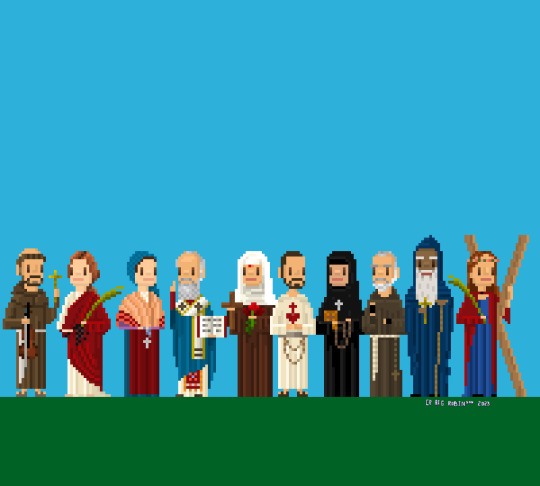
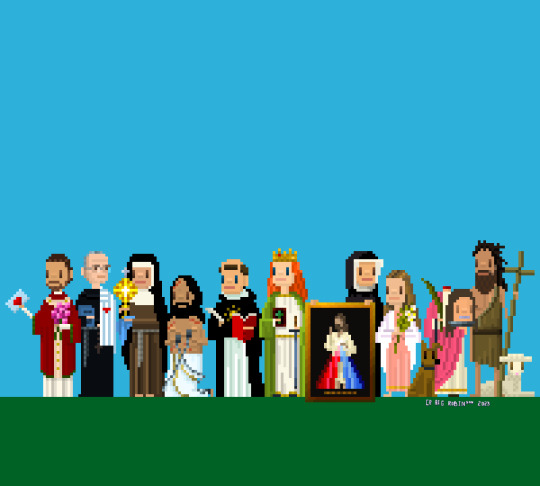
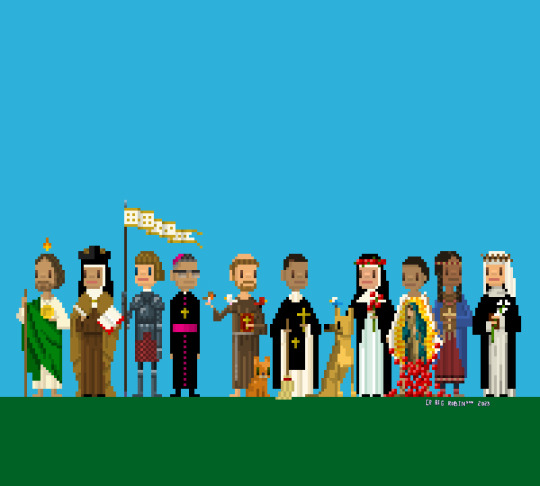
SOME PIXELLY DRAWINGS OF SAINTS
Francis Solanus, Bibiana, Bernadette, Athanasius of Alexandria, Rita of Cascia, Charles de Foucauld, Rafqa, Pio of Pietrelcina, Moses the Black, Eulalia of Barcelona.
Valentine, Maximilian Kolbe, Clare of Assisi, Devasahayam Pillai, Thomas Aquinas, Dymphna, Faustina Kowalska, Maria Goretti, Quiteria, John the Baptist.
Judas Thaddeus, Teresa of Ávila, Joan of Arc, Óscar Romero, Francis of Assisi, Martín de Porres, Rosa of Lima, Juan Diego Cuāuhtlatoātzin, Kateri Tekakwitha, Catherine of Siena.
41 notes
·
View notes
Note
oooh, this poll is shaping up to be WILD. i would like to submit saint moses the black and saint lawrence, please!
We got St Lawrence for sure but with so many submissions you'll have to fight for Saint Moses the Black!! This is the first nomination I've got for him, so send in your best propaganda to get him more votes!
#st lawrence#st moses the black#catholic#catholic saint tournament#catholic church#catholic saints#saints#christianity#send in your propaganda
8 notes
·
View notes
Text

Prayer to St. Moses the Black (sometimes referred to as Saint Moses the Ethiopian)
Thou didst forsake temporal riches, earthly fame, and fleshly pleasure and didst freely choose a life of poverty and deprivation to become rich in spirit. Having tasted the momentary sweetness of sin, thou didst foresee the bitter end that awaits a life of self-indulgence. Having stained thy hands with the blood of thy brother, thou didst foretaste the anguish of hell. From this pit, thou didst cry out to God Who raised thee up as a testimony of His almighty power. In thy ascent to near the Living God thou didst not spare thyself but willfully endured a life of hardship and struggle. By following the path of the Cross, thy soul was empowered by the might of the Holy Spirit, thy mind was illumined with the understanding of things divine, and thy heart was filled with the burning love of God for thy fellow man. And though thou didst live in ancient times and in a distant land, today we find ourselves faced with the same struggle to overcome the evil that lies within us. In these perilous times, we call on thy prayers—help us! For our brothers and sisters are dying daily and our children are born hopeless in a world barren of Christian love. Amidst these trials, we waver because our faith is weak and we know not how to endure suffering courageously. Pray that we be strengthened to live uprightly, walking in the light of the holy Gospel, ever seeking to do the will of God. And in the dreadful day of judgment, pray that we may be received with His Unoriginate Son, and His most holy and life-creating Spirit, to whom belongs all glory, honor, and worship, now and ever and to the ages of ages. Amen.
8 notes
·
View notes
Text
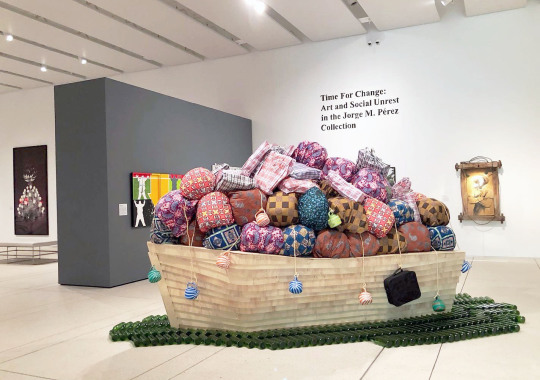
Barthélémy Toguo, “Road to Exile”, 2018. Wooden boat, cloth bundles, glass bottles, and plastic containers
Currently on view at Tampa Museum of Art is Time for Change: Art and Social Unrest in the Jorge M. Pérez Collection. The exhibition highlights art from around the world that focuses on social issues.
From the museum-
“It is enough for the poet to be the bad conscience of his age”, stated Saint-John Perse in his 1960 Nobel Prize acceptance speech. Something similar could be said when artists address the transformations of society. We should not ask for measurable political action when their role is to point out, to render evident, to shake us from indifference. Art may not provide answers, but most of the time it interrogates and proposes uncomfortable issues, almost like rubbing salt in a wound. Artists are seldom celebratory, nor do they usually provide solutions-art’s potency lays in the symbolic efficacy of the actions it proposes more than in the practical effects they entail. Paraphrasing Brazilian poet Ferreira Gullar, “art exists because life is not enough.”
Time for Change is structured around six themes or nuclei: Entangled Histories, Extraction and Flows, Artivism, State Terror, Spatial Politics, and Emancipatory Calls. The sections are organically linked and establish dialogue and correlations among artworks that do not necessarily illustrate an argument nor are they contained by one. Entangled Histories proposes essential questions: how do we remember as a society? Who is forgotten by History, and for what reasons? Extraction and Flows examines displacement of peoples (usually forced), as well as the unequal logic on the territory. Artivism: Art in the Social Sphere focuses on political unrest and public protest on the streets. State Terror signals how protest is countered with repression and violence. The fifth section, Spatial Politics, reflects on modern architecture and its role in creating segregated communities. Lastly, Emancipatory Calls summons to reclaim difference, in the understanding that a more just society can only be built on respect for one’s right to be different.
A comprehensive look at the Jorge M. Pérez Collection reveals a tendency towards art with an interest in social change- art that examines the conflicts and contradictions of contemporary society, art that critically analyzes historical events and reframes them in the present. Many of the 60 works on view, due to their size or complexity have rarely been exhibited and are shown together for the first time in Time for Change.
About the main work pictured above, Barthélémy Toguo’s Road to Exile, from the museum–
In 2018, the Parrish Art Museum in Water Mill, New York hosted Barthélémy Toguo’s first solo exhibition in the United States. While on site at the Parrish he made Road to Exile, a large-scale installation highlighting the plight of refugees, in particular African migrants in search of a better and safer quality of life. The installation features a life-sized wooden boat that rests on glass bottles. A metaphor of the dangerous voyage across the sea, the bottles represent the fragile line between life and death. The boat nearly overflows with bundles wrapped in brightly colored African textiles and serve as stand-ins for the body. In Road to Exile Toguo employs imagery of the boat as a means of escape rather than a vessel for exploration or adventure.
Below are images from the exhibition as well as some information on a few of the works.

Rashid Johnson, “A Place for Black Moses, (2010), bottom right sculpture; and Christopher Myers “How to Name a Famine, a Fire, a Flood”, 2019, left wall piece
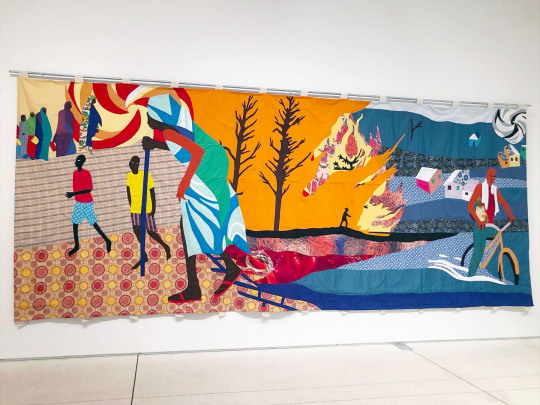
From the museum about the above work-
Storytelling anchors Christopher Myers’ artistic practice. Working in a range of media, he mines history and creates art that links the past to the present. Myers’ tapestries, such as How to Name a Famine, a Fire, a Flood draws on the rich tradition of quilt making as a quiet yet radical form of resistance and protest. The stories depicted center on the effects of globalization on individuals and more specifically, communities of color. In How to Name a Famine, a Fire, a Flood, Myers portrays three different natural disasters linked to climate change. With vivid color and patterned fabric, he illustrates the impact and devastation of these catastrophic events in neighborhoods with minority populations.
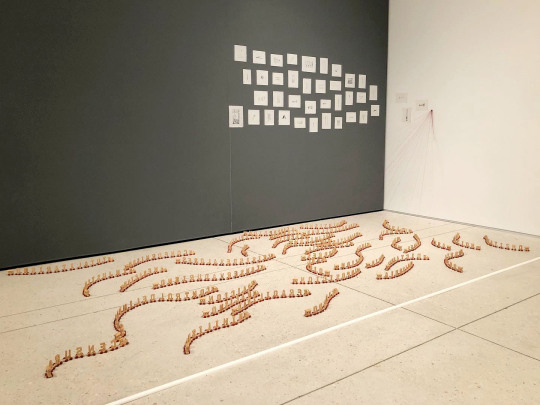


Carlos Garaicoa “La habitacion de mi negatividad (The Room of My Negativity)”, 2003, 39 ink and pencil drawings on rice paper and toy train installation
About the above work from the museum-
Carlos Garaicoa works in a variety of media, ranging from installation, photography, and video to performance and public interventions. His early work in the 1990s focused on the urban decay of Havana as result of its political climate and economic strife. La habitacion de mi negatividad (The Room of My Negativity), turns Garaicoa’s lens inward. In this installation, comprised of toy trains and drawings of medical instruments, the artist explores his psyche and subconscious. The train’s engine pulls words that represent Garaicoa’s negative thoughts. Each train is connected to thin red thread that acts as a vein or conduit for the negative thoughts to travel. Arrange in a curved form, the train shapes mimic brain waves or the slink of a snake. Garacoia’s drawings of medical tools serve as mechanisms in which the negatively could be excavated from one’s mind.

Esterio Segura, “La historia se muerde la cola (History Bites its Tail)”, 2015, (statue bottom left); Anamaría Devis, “Infinito (Infinite)”, 2018 (upper right)


Anamaría Devis, “Infinito (Infinite)”, 2018, Ink on paper
About this work from the museum-
Anamaría Devis’ large-scale installation Infinito (Infinite) represents the artist’s study of African history in San Basilio de Palenque, Colombia. Escaped slaves founded Palenque and it was the first free town in the Americas during colonial times. While researching this history, Devis discovered that in this region of Colombia, braided hairstyles worn by Africans served as escape maps. Braid patterns reflected safe points in the area’s topography. This silent form of resistance inspired her to look at other bodily topographies like the characteristics of fingerprints, which also had names associated with cartography such as crossing, island, and fork. Devis then began to create drawings that incorporated footprints, braid patterns, and elements of nature. From the drawings she made stamps and each panel of paper that comprises Infinito (Infinite) is rendered from Devis’ various imprints. The result is an abstract representation of the body and landscape visualized through mapping and codes.

Jonathas de Andrade, “A batalha de todo dia de Dona Luzia, de Tejucupapo (The daily battle of Dona Luzia, from Tejucupapo)”, 2022 Images printed on raw falconboard
About this work from the museum-
Jonathas de Andrade collaborated with the Brazilian theater company Teatro Heroínas de Tejucupapo to create a visual reenactment of the historic 1646 Battle of Tejucupapo. For nearly 25 years, between 1630 and 1654, the Dutch occupied the northeast of Brazil including Tejucupapo, a small community in the city of Goiana. During the Battle of Tejucupapo, a brigade of black and indigenous women forced Dutch soldiers to retreat by arming themselves with household and farm objects. The Teatro Heroínas de Teiucupapo commemorates this female-led rebellion each April by restaging the battle with local actors.
Artist Jonathas de Andrade celebrates the power and courage of Tejucupapo’s women with his large-scale photographic installation A batalha do todo dia de Tejucupapo (The Battle of Tejucupapo). The work on this wall, A batalha de todo dia de Dona Luzia, de Tejucupapo (The daily battle of Dona Luzia, from Tejucupapo), presents everyday objects from the home of one of the women participating in Teatro Heroínas de Tejucupapo. This inventory explores the daily struggles, as well as strength, of Brazil’s black and indigenous women that have spanned centuries.
This exhibition will close on Sunday, 8/27/23.
#Anamaría Devis#Art#Art Installation#Art Shows#Barthélémy Toguo#Carlos Garaicoa#Christopher Myers#Drawing#Esterio Segura#Florida Art Shows#Installation Art#Jonathas de Adrade#Mixed Media#MIxed Media Art#Painting#Parrish Art Museum#Photography#Political Art#Rashid Johnson#Sculpture#Social Change#Tampa Art#Tampa Art Shows#Tampa Museum of Art
8 notes
·
View notes